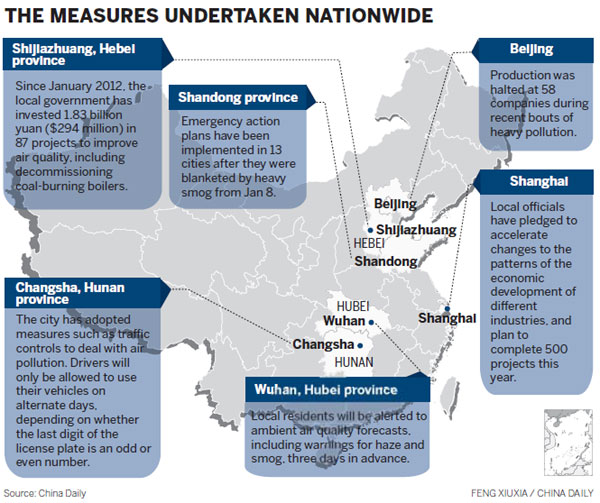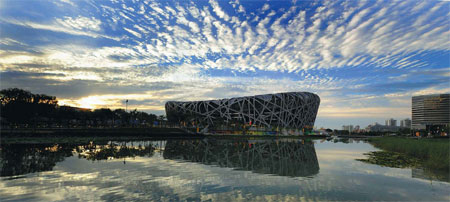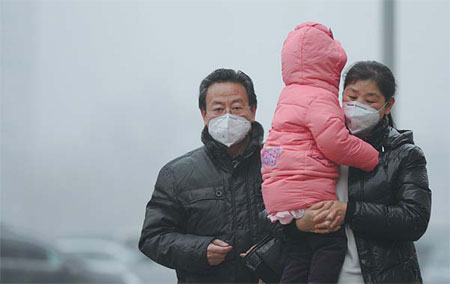Blue-sky thinking may need new Olympian vision
Updated: 2013-01-24 07:21
By Wu Wencong, Cui Jia and Tang Yue (China Daily)
|
||||||||
|
The iconic China Central Television building is shrouded in heavy fog on Wednesday. Han Haidan / for China Daily |
|
The Bird's Nest stadium under a blue sky on Aug 1, 2008. Experts have dismissed calls for a return to the measures adopted to control airborne pollution during the Beijing Olympics. Yang Lei / Xinhua |
|
Severe haze and smog covering the Bird's Nest on Wednesday. Wei Xiaohao / China Daily |
|
Beijing was hit by another bout of heavy pollution on Wednesday, resulting in poor visibility. Luo Xiaoguang / Xinhua |
Summer of 2008 remembered fondly for victory over air pollution, report Wu Wencong, Cui Jia and Tang Yue.
It's now four and a half years since Beijing hosted the Olympic Games, and the event is frequently recalled with affection.
But the nostalgia is not centered on the fine displays of athleticism or the exciting opening ceremony. Instead, the smog and haze that have enveloped the capital in recent weeks have left people hankering for the blue skies and clean air that accompanied China's sojourn in the sporting spotlight.
Du Shaozhong, deputy head of the Beijing Municipal Environmental Protection Bureau in 2008, inevitably thinks of those days with great pride.
But he said the fresh air in 2008 was a special circumstance and the result of temporary anti-pollution measures, rather than something the city's residents can expect all year round, at least for now.
"Judging by the current situation, I would call it a 'Chinese miracle' if Beijing can solve its pollution problem within 20 years," said Du, who is now the director of the China Beijing Environment Exchange.
Many of the measures adopted to control airborne pollution during the Beijing Olympics were unprecedented and cannot be repeated, he said.
As the capital of the world's second-largest economy, the quality of the air in Beijing is an important factor in the country's reputation and political image, according to a report released by the Beijing Municipal Environmental Protection Bureau earlier this month.
To better protect the athletes and present the world with the picture of a city that boasts clear blue skies rather than being shrouded in smog, China made the improvement of air quality a national goal during the 2008 Games.
Backed by the central government, six cities, including Beijing, the neighboring municipality of Tianjin, and nearby provinces, implemented an extraordinarily varied series of measures that resulted in a marked improvement in the quality of the capital's air between July 20 and Sept 20, 2008.
Beijing closed down as many as 150 highly polluting chemical engineering and cement factories. Most of the closures were temporary, but a few were permanent. Furthermore, thermoelectric-power generating companies were ordered to reduce emissions of pollutants by 30 percent through the use of low-sulfur coals and the installation of desulfurization units.
"Those were indeed intense measures, adopted over a very large area, and they produced pleasant air quality for Beijing during the 17-day Games," said Du. He noted that the average concentration of particulate matter was reduced to a record low for the time as the total emissions of airborne pollutants was cut by 60 percent.
However, if those measures had been implemented over the long term after the Games, it would have been difficult for people in the provinces surrounding the capital to maintain normal production and life, said Zhang Lei, an associate professor who studies environmental policies at the School of Environment and Natural Resources at Renmin University of China.
She said that more comprehensive and sustainable measures are needed to address the problem and the country should not be solely reliant on emergency action plans.
"Environmental protection work in China is still largely based on responding to emergencies and trying to clear up the mess only when things go wrong," said Zhang.
"It's like before you can prop up a fallen bottle, another one also falls, because the pace of our development is so rapid and the problems so diverse that we have no time to study each of them thoroughly enough or to prepare fully."
Traffic controls
During the Beijing Games, vehicles were only allowed on the capital's roads on alternate days, depending on whether the last digit of the driver's license plate was an odd or even number. In addition, more than 70 percent of government vehicles were banned from using the roads.
To ease traffic jams and air pollution, the vehicle controls continued after the Games but in a much lighter form. Currently, each car is banned from the road on one day on Monday through Friday within the areas of the Fifth Ring Road, depending on the license plate number, but there are no constraints at weekends.
However, the number of vehicles has increased sharply in Beijing. The city saw the number of vehicles rise by 515,000 in 2009 and a further 800,000 in 2010. To cope with the problem, a new system was introduced in 2011 to ensure that only 240,000 license plates were awarded annually.
During the recent severe smog, the levels of PM2.5 - particle matter smaller than 2.5 microns and able to enter the lungs and even the bloodstream - passed 900 micrograms per cubic meter on Jan 12. The World Health Organization considers the safe daily level to be 25 micrograms per cu m. However, the local transportation authority declined the opportunity to reintroduce the regulations in force during the Olympics as a long-term measure.
"Complaints can already be heard everywhere about the current regulation that only allows each car on the roads one day a week, so three or four days is not an option," said Du.
Government vehicles are also targeted when the situation is particularly dire. Thirty percent of official cars should disappear from the roads during highly polluted days, according to emergency procedures in Beijing and Shijiazhuang, the capital of Hebei province.
Energy consumption
Back in 2008, five cement factories in Taiyuan, the capital of Shanxi province, were required to reduce production by 50 percent and another five were temporarily closed until the Games had ended. Moreover, officials were sent to high pollution-generating manufacturers to monitor their production over the course of a day and to randomly inspect the quality of the coal or petrol being used.
Similar measures were also adopted in the municipality of Tianjin, and in Hebei province and the Inner Mongolia autonomous region.
However, the short break was unable to slow the ever-increasing consumption of energy nationwide. Coal production and consumption have tripled since 2000, while steel output is approximately five times higher.
"We are experiencing the high-speed development of the manufacturing industry. Under these circumstances, a solution to the problem of pollution is not just around the corner," said Su Yang, a senior research fellow at the State Council's Development Research Center.
While he admitted that China faces challenges, he was critical of the measures in the UK, saying that although the country has reduced pollution levels it has also almost completely given up on manufacturing.
"The manufacturing sector is the backbone of a great country," he said, adding that China can learn from Japan and Germany and try to adjust the patterns of economic development for different industries, thus reducing the proportion of sectors with high levels of pollution.
"The technologies involved in the manufacturing industry also need to be improved," said Su. "For example, Japan has the world's lowest level of emissions per unit of output value. If China could also achieve that, a lot of emissions could be reduced."
Forecasts, warnings
Wang Yuesi, a researcher in atmospheric physics at the Chinese Academy of Sciences, said airborne pollutants in Beijing caused by sources from outside the capital account for about one-third of the city's pollution.
Judged by types of source, motor vehicles produce approximately 50 percent of the city's air pollution.
Wang said if the public wants change in the short term, all it can count on is the development of the weather forecast and warning systems.
"For example, if the forecast shows that we are expecting smog and haze in the week to come, we can take preventive measures such as regulating the use of motor vehicles, or halting production and foundation work in factories and construction sites for several days ahead of it," said Wang. "After all, pollution as severe as last week's is unlikely to occur more than three times in a year, and thus can be dealt with by implementing short-term controls if the warnings are given in time."
In an ideal world, the warnings would be issued five to seven days in advance, so that the relevant departments have enough time to prepare, he said.
"We now possess the technology to make such a forecast, with accuracy of about 50 to 60 percent, which is pretty high," said Wang. "Also, scientists should only be responsible for informing the government about the possibility of bad weather. The authorities need to have the final say on whether emergency plans need to be implemented because they usually incur sizable economic losses."
As for the control of private cars, Wang didn't agree with making it a permanent regulation, but said the government can let the public know about the situation and suggest appropriate action.
"For example, the government can inform the public that the weather in the following days will make it hard for pollutants to diffuse, and then call on people to use public transport. By promoting the measures gradually, we can avoid public resentment on this issue."
Contact the reporters at wuwencong@chinadaily.com.cn, cuijia@chinadaily.com.cn and tangyue@chinadaily.com.cn

(China Daily 01/24/2013 page6)

 In Photos: 7.0-magnitude quake hits Sichuan
In Photos: 7.0-magnitude quake hits Sichuan
 Li Na on Time cover, makes influential 100 list
Li Na on Time cover, makes influential 100 list
 FBI releases photos of 2 Boston bombings suspects
FBI releases photos of 2 Boston bombings suspects
 World's wackiest hairstyles
World's wackiest hairstyles
 Sandstorms strike Northwest China
Sandstorms strike Northwest China
 Never-seen photos of Madonna on display
Never-seen photos of Madonna on display
 H7N9 outbreak linked to waterfowl migration
H7N9 outbreak linked to waterfowl migration
 Dozens feared dead in Texas plant blast
Dozens feared dead in Texas plant blast
Most Viewed
Editor's Picks

|

|

|

|

|

|
Today's Top News
Live report: 7.0-magnitude quake hits Sichuan, heavy casualties feared
Boston suspect cornered on boat
Cross-talk artist helps to spread the word
'Green' awareness levels drop in Beijing
Palace Museum spruces up
First couple on Time's list of most influential
H7N9 flu transmission studied
Trading channels 'need to broaden'
US Weekly

|

|











